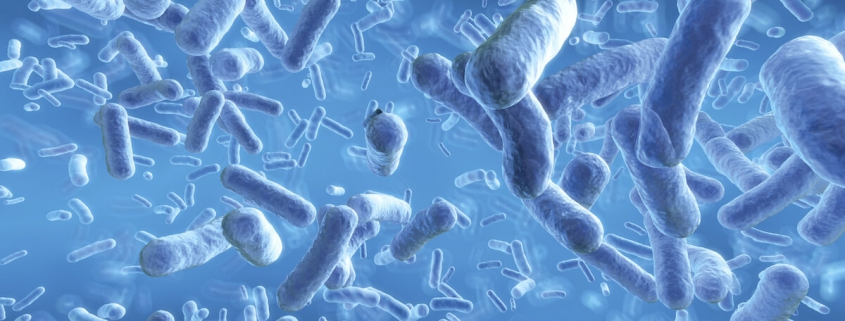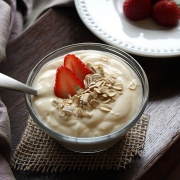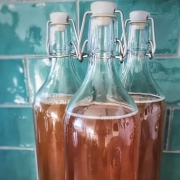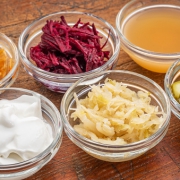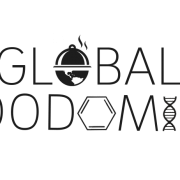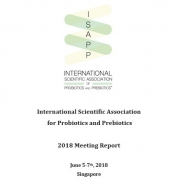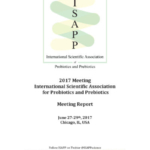Suggestions for Making Safe Fermented Foods at Home
September 2017 – By Drs. Bruno Pot and Frédéric Leroy, Vrije Universiteit Brussels, Brussels, Belgium.
The impact of lifestyle on the composition and diversity of the human gut microbiota over the last five decades has been tremendous. This is thought to be mainly the result of a cumulative effect ascribed to the increased use of antibiotics and other drugs as well as dietary changes, including consuming less fermented foods that contain live microorganisms.
Fermented foods are important for a healthy diet, as they have the potential to improve the microbiota quality and diversity, are related with reduced disease risk, and can provide essential nutrients. Consumers are constantly being informed about these benefits, leading to pleas for a return to home-made fermented foods. However, there is rarely mention of the risks that home-made natural fermentations can entail. While making fermented foods at home can be a good idea and help you consume more beneficial microbes, we should realize that the empirical knowhow, skills and equipment to make safe food fermentations may have disappeared over time. This blog is a gentle warning about the possible risks of non-controlled fermentations.
- Use a starter culture: The use of specific starter cultures at sufficiently high concentration is recommended to properly initiate the fermentation of specific foods and to obtain sufficient control over the process. Relying on spontaneous fermentation (i.e., hoping that environmental bacteria or yeasts initiate the fermentation) increases the risk that uncontrolled fermentations by unsuitable bacteria, yeasts and molds will result in bad or variable quality. In the worst case, dangerous end-products will be obtained.
- Twice is nice: Starters should not be used repeatedly. Because bacteria multiply several times per hour, their genetic material is changing continuously and the quality of the starter will change over time. It is therefore not a good idea to re-use your ‘old’ product to restart a ‘new’ fermentation all too often, although some fermented food ecosystems such as sourdough or water kefir may usually be ‘backslopped’ frequently. The risks are that off-flavours will be formed or that acidification, which protects your food against the growth of spoilage or pathogenic bacteria, will be too slow.
- Choose wisely: Not all starters are necessarily safe, although commercially available ones should in principle have been checked for safety (See Helpful Information links below for guidance on findings the right starter). Some yeasts and lactic acid bacteria (LAB) can form compounds (for example, biogenic amines from amino acids) that can result in many health troubles like headache, blood pressure drops, diarrhoea, and even heart problems. You can avoid the production of biogenic amines by using selected starters that do not have the metabolic machinery to make them.
- To breathe or not to breathe: Some fermentations, like the production of water kefir (usually using dried figs), should be performed in the absence of air and thus require a rubber sealing. For other fermentations, a complete submerging in brine or a covering with oil is necessary. Kombucha, on the contrary, needs a wide opening covered by a cloth that allows oxygen into the vessel. Uncontrolled anaerobic conditions can increase the risk for the growth of clostridia. In cheese making they can be the cause of cheese blowing up, in other conditions they may produce the deadly botulin toxin.
- Avoid Moulds. Moulds are another problem linked to (too much) oxygen. Moulds can make mycotoxins which can make one very sick and any visible contamination should ring bells! It is not wise to scrape them off, as often they have produced toxins already, left spores or will remain present through their ‘roots’ which most of the time are not visible.
- Hold the alcohol: During fermentation, sugars are converted to lactic and acetic acids, but also to ethanol. Therefore, the concentration of sugar added may impact the final alcohol levels of the end-product.
- Pass the gas: In the case of water kefir, the use of a water lock can be necessary, as the CO2 gas which is formed during the fermentation may increase the pressure in the vessel, leading to potential breaking or surprises during opening. Therefore, blown fermented foods products should never be consumed.
- Party crashers and acid balance: Not all bacteria are your friends. Some undesirables can be present on fresh vegetable products and can in themselves lead to spontaneous fermentation. Therefore, it is important to not let your fermentation be hijacked by these bacteria. The good bacteria should grow and produce acid quickly for a safe fermentation. Pathogens generally cannot grow in high acid environments (below pH 4 is a safe target). This acidity should be reached as quickly as possible during fermentation to avoid the growth of bacteria which can produce toxins or off flavours.
- Nothing lasts forever: While high acid is essential, it does not protect the food indefinitely. Some yeasts and fungi can grow in high acid. As they grow, some can reduce acidity locally so that (mainly at the surface) other (potentially pathogenic) bacteria can develop
- Use good quality raw materials. Use only good quality and fresh ingredients when deciding to ferment. While fermentation helps to preserve your fresh foods longer, it will not rescue (almost) spoiled products!
- Summer and winter milk. If you use milk in your fermentation, it is also possible that the quality of the end product will be different along with the season, as summer milk, harvested from cows in the field, has a different composition from milk harvested from cows fed winterfeed.
- Temperature. Temperature control is important. While for sauerkraut room temperature 18-22 (65-72°F) is fine, yoghurt fermentation is much better at 37°C (100°F). You, therefore, can expect differences in summer and winter if you do not control the temperature. Find the right spot in the house for both summer and winter.
- Water activity. In addition to acidification, microbial control is often achieved by reduction of the water activity, generally by sufficient salting and/or drying. This is of major importance to produce fermented sausages. It is important to point out that raw meat is a particularly hazardous matrix, requiring even more care and attention when performed at home.
- Salt and acetic acid (vinegar) concentration. Both ingredients help keep the pathogens at bay. Stick to recipes that have proven to be reliable.
- Fermentation time. This is an important factor which can vary a lot and, in turn, impact the quality of your end product. Its critical nature is well known from wine making, in which the duration of the primary and secondary fermentation is well known to be crucial to the quality of the result. While in wine the primary fermentation usually takes between 3 to 7 days, the secondary fermentation can take much longer and will depend on the vial, the alcohol concentration and the yeast used. The fermentation of sauerkraut goes in three stages. ALL three are essential for a safe and tasteful product; a minimum of three to four weeks is necessary. Industrially produced yoghurt can be made in 8 hours, but at home it may take a few hours more. How much more again depends on the milk quality, the starter and the temperature.
- Do’s and don’t’s: Do invest in a kitchen weighing scale and a thermometer that goes from 0 – 100 °C. Don’t even think about home-made sausage. Don’t even think about raw-milk cheese. Do start with simple foods like yogurt or kefir. There are fool-proof kits for making beer (although they require some hardware). Sauerkraut and kimchi are relatively easy to make.
Being aware of these simple concepts can help ensure the production of a healthy, tasty fermented food. Consumers should expect that the quality of the resulting fermented food will vary from lot to lot and they should be able to judge when a product is still safe for consumption and when it is not. Consumers should also be aware of the risk factors above and know how to select and handle equipment and execute procedures that will yield safe and nutritious end products.
For additional information:
Fermented Foods on the www.ISAPPscience.org website.
Preparing Fermented Foods and Pickled Vegetables
The University of Georgia Cooperative Extension, the National Center for Home Food Preservation
Safe Preserving: Fermented Foods From the University of Wisconsin Extension

